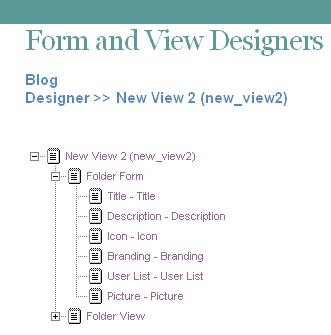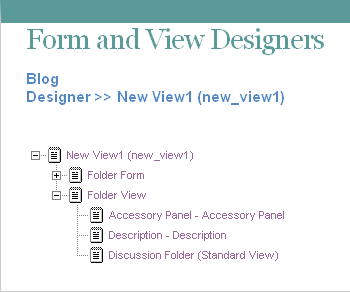8.2 Designing a Custom Folder View
The steps in this section describe how to customize (design) a folder view after it has already been created. For information on how to create a folder view, see Section 8.1, Creating a New Custom Folder View.
You can design a folder view immediately after you define it, or you can modify the design of an existing folder view. For information on how to modify an existing folder view, see Section 8.3, Modifying an Existing Folder View.
Teaming enables you to design the workspace form and the workspace view. You must design both the folder form, and the folder view in order for your changes to be displayed in the folder.
8.2.1 Designing the Folder Form
The section in the Form and View Designers tool lets you choose the features you want to include in your folder.
After you add elements and layout options to the folder form, you must then add those same elements and layout options to the folder view in order for them to be displayed in your folder. For information on how to add features to the folder view, see Adding Additional Elements to an Entry View Definition.
Teaming provides you with all of the tools necessary to create a folder form that suits any of the purposes that you want to accomplish with your folder.
-
Expand the custom folder form that you previously defined.

-
Add the desired elements and layout options, as described in the following sections:
Adding Additional Elements to a Folder Form
-
Click .
-
In the Folder Form window, on the right side of the page, click .
-
In the section, click the element that you want to add.
For information on the types of elements that you can add, see Section 8.6.1, Folder Form Elements.
-
Specify the appropriate information.
-
Click .
Modifying Elements in a Folder Form
-
Expand , then click the element that you want to modify.
-
In the window on the right side of the page, click .
-
Make the desired modifications, such as changing the caption or data name, then click .
Based on the modifications that you make to a form element, you might need to make the same modifications to the corresponding view element.
Adding Additional Layout Options to a Form
-
Click .
-
In the Folder Form window, on the right side of the page, click .
-
In the section, click the layout option that you want to add.
For information on the types of layout options that you can add, see Section 8.7, Understanding Layout Options.
-
Specify the appropriate information.
-
Click .
8.2.2 Designing the Folder View
The folder view is how your folder form is displayed to other users. Every folder form must have a view associated with it. This view needs to contain all of the elements that you want to display in your folder.
Teaming provides you with all of the tools necessary to create a folder view that suits any of the purposes that you want to accomplish with your folder.
-
Expand the custom folder view that you previously defined.

-
Add the desired elements and layout options, as described in the following sections:
Adding Additional Elements to a Folder View
-
Click .
-
In the Folder View Definition window, on the right side of the page, click .
-
In the section, click the element that you want to add.
For information on the types of elements that you can add, see Section 8.6.2, Folder View Elements.
Before you can add some of these elements to your Folder View, you must first add them to the Folder Form. For information on how to do this, see Adding Additional Elements to a Form.
-
Specify the appropriate information.
-
Click .
Adding Additional Layout Options to a Folder View
-
Click .
-
In the Folder View window, on the right side of the page, click .
-
In the section, click the layout option that you want to add.
For information on the types of layout options that you can add, see Section 8.7, Understanding Layout Options.
-
Specify the appropriate information.
-
Click .